You are using an out of date browser. It may not display this or other websites correctly.
You should upgrade or use an alternative browser.
You should upgrade or use an alternative browser.
V-241 from scratch
- Thread starter DaveP
- Start date
Help Support GroupDIY Audio Forum:
This site may earn a commission from merchant affiliate
links, including eBay, Amazon, and others.
Excellent design of chasis, component placement/shielding and circuit. Choice of transformers and small signal circuit below the rest reminds me of how Fearn does some of his things, although yours should last much longer and it is custom. Don't see this often anymore so thanks for sharing.
I red your pentode tests, do you use EF86 types in other preamps, or is it first time you spend so much time on it? I like them a lot and tests thread gave lots of hints like a-g2 voltage ratios...
I red your pentode tests, do you use EF86 types in other preamps, or is it first time you spend so much time on it? I like them a lot and tests thread gave lots of hints like a-g2 voltage ratios...
The first EF86 amp I made was a Mullard 5-10 for my HiFi back in 1970, the power supply caps finally gave out in the mid 80's. Before that I had modified my Selmer 100W PA to take Treble and Bass controls. In my 20's I tried to make a 4 track tape deck with EF86 amps but I could not get the tape bias sorted as I was too poor to buy a scope and VVM, I had no way to tell what was going on, so that was a total failure.I read your pentode tests, do you use EF86 types in other preamps, or is it first time you spend so much time on it? I like them a lot and tests thread gave lots of hints like a-g2 voltage ratios...
Recently I made a REDD47 which I found disappointing, it did not have the best operating point for the EF86 for low noise and it sounded dry and dead. I made a VOX AC4 for a guy to use for his harmonica, it sounded divine for that and guitar too. I made a mic pre for my studio using an EF86 triode wired and an EL84 for the output with no feedback, I was happier with that.
For this V 241, I have bought the best transformers in the business as I'm trying to make a world class mic-pre this time. I'm hoping that the choke loading will give it a special vibe, as will the V76 front end with the same EF86 I used for the pentode tests. It will be interesting to see whether or not I have been successful. Thanks for your interest.
DaveP
Final assembly.
I first cut out paper templates and then pieces of the MuMetal foil to line the choke box.
Note small square under the choke.

Top section
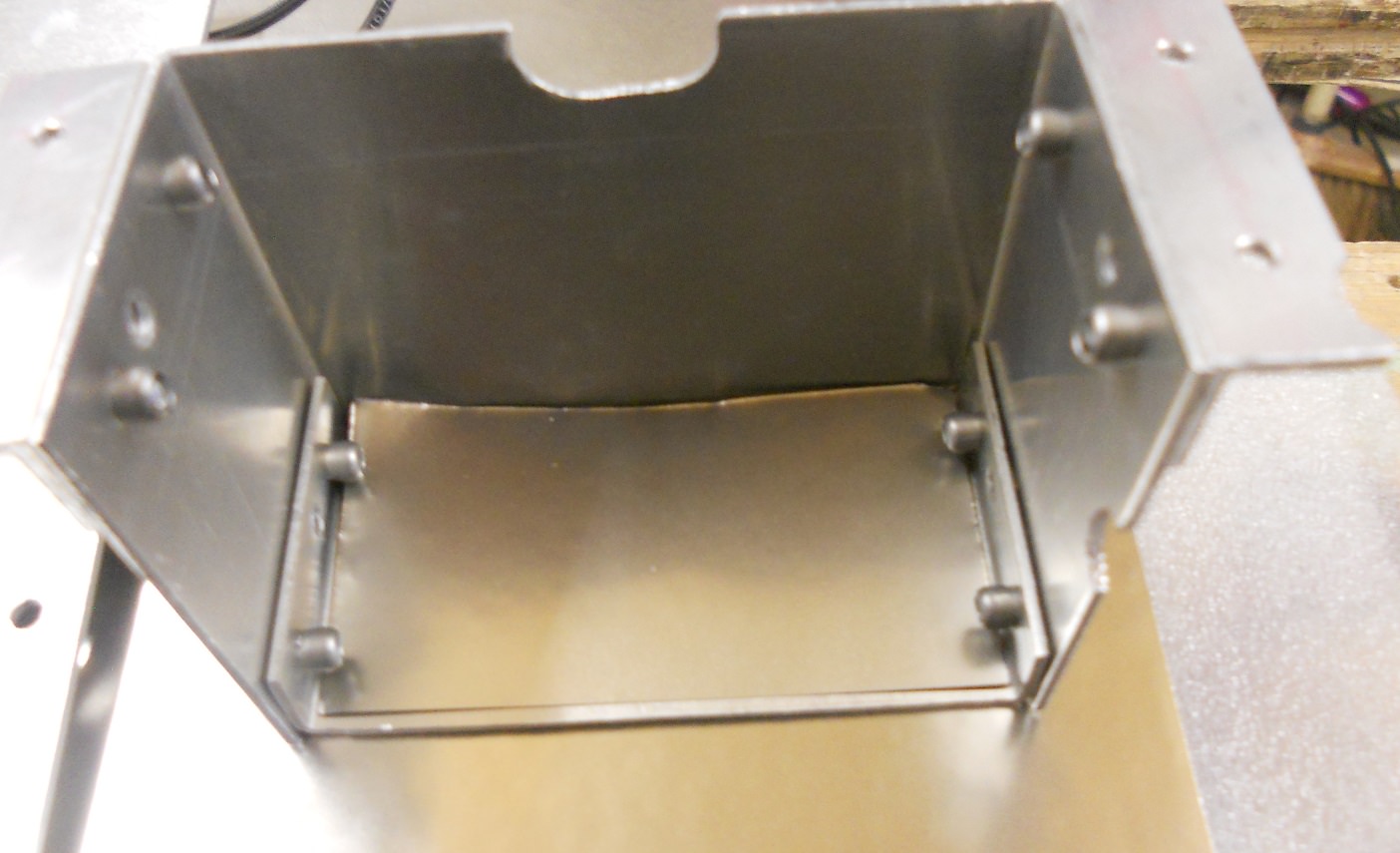
Wrap around
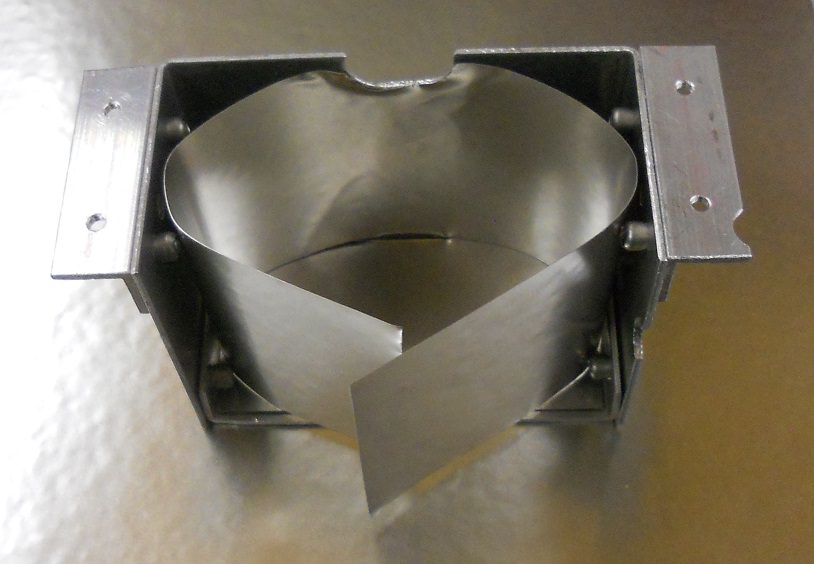
Sealed with sticky-backed copper foil
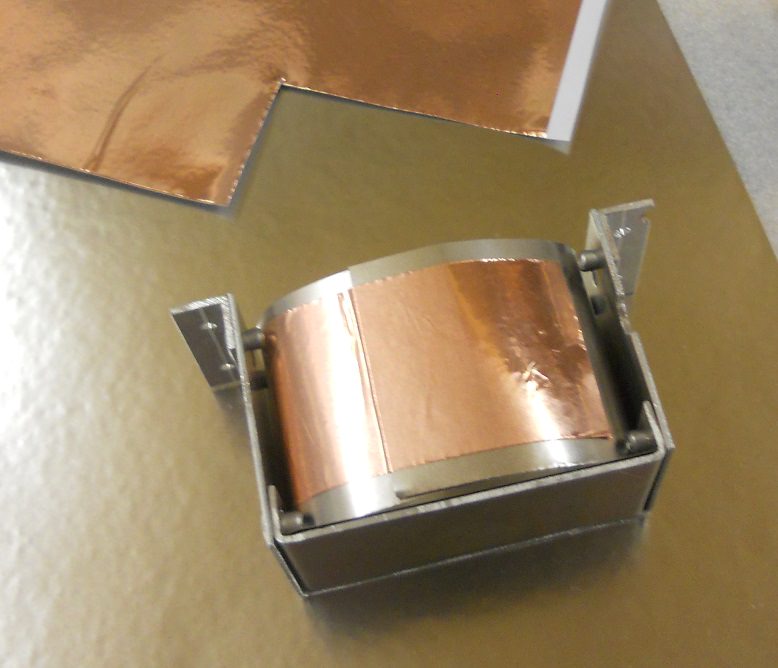
Major components now in place
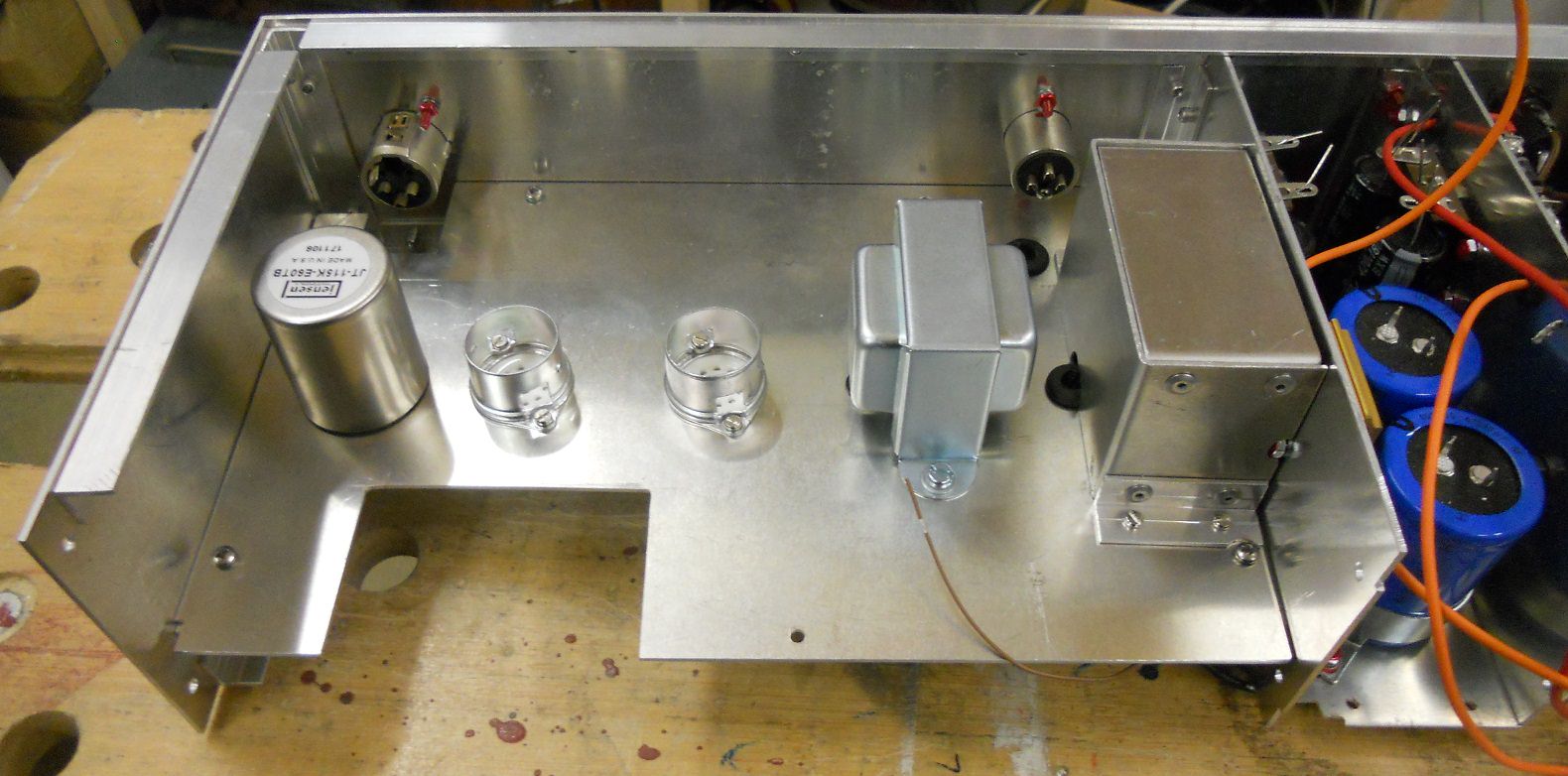
View of underside
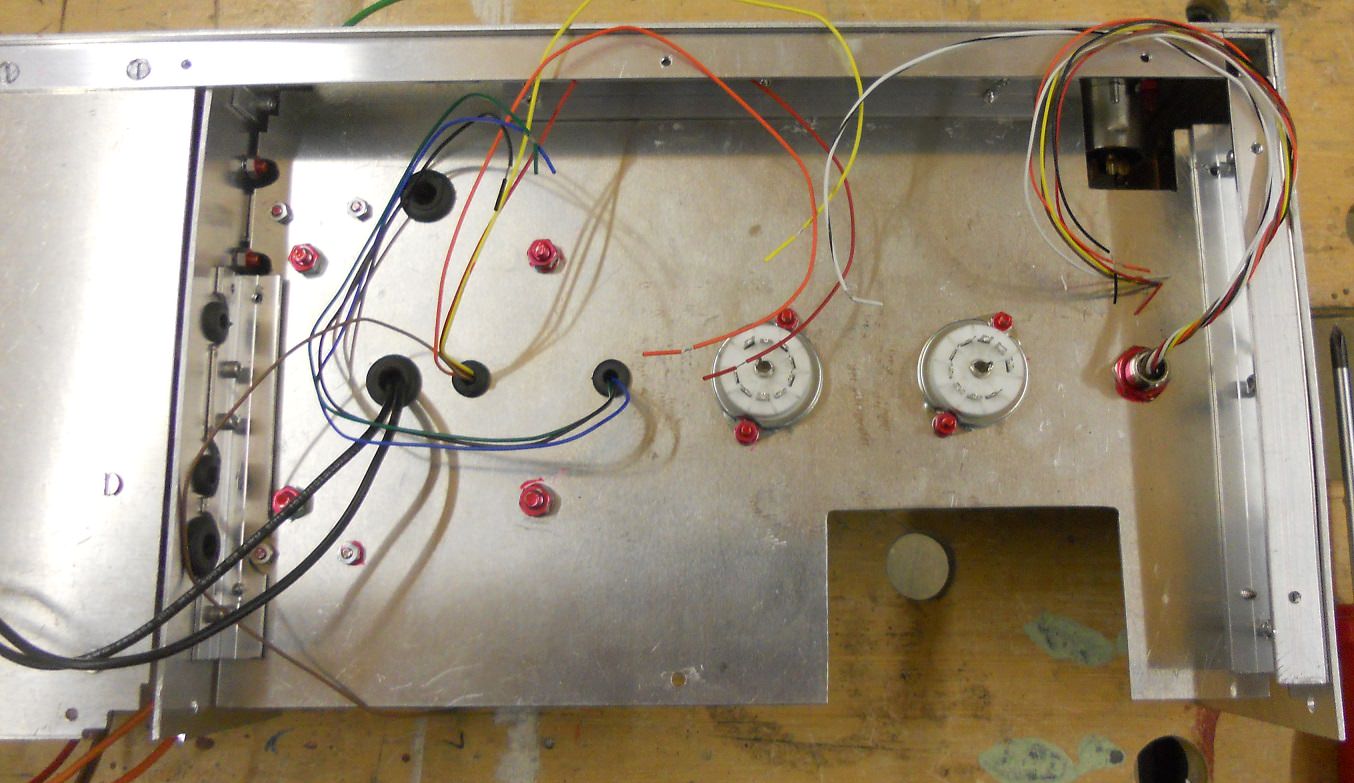
This side now needs to have the small component layout designed.
Plenty to do now
DaveP
I first cut out paper templates and then pieces of the MuMetal foil to line the choke box.
Note small square under the choke.

Top section

Wrap around

Sealed with sticky-backed copper foil

Major components now in place

View of underside

This side now needs to have the small component layout designed.
Plenty to do now
DaveP
Very Cool Work DaveP! A couple things I noticed on your schem on page 2, compared to the original. R14 should be on the other side of C10 output cap. It looks like R6 and C4 positions are reversed. Maybe you already tried that but both C9 and C2 are already blocking DC on the NFB path. So my thought is that you could do away with them That switch on the original schem is hurting my head. 
I would just use the V241 NFB/Cathode switches. They are changing V1's Cathode on the first 3 positions, while switching NFB with HF filtering around 20K-24K and 30K at 40 dB.
Looking forward to hearing this bad boy.
I would just use the V241 NFB/Cathode switches. They are changing V1's Cathode on the first 3 positions, while switching NFB with HF filtering around 20K-24K and 30K at 40 dB.
Looking forward to hearing this bad boy.
Well spotted Guavatone,
The reason for these small changes is because I have incorporated part of the V76 input circuit into the V241.
The published noise for the V241 is about -69dB whereas the V76 is around -118 to -120dB depending on the weighting used.
Remember that the OPT is completely different as is its inductance so I have used C9 (from the V76) to avoid interaction with the self resonance of the OPT and C10.
C2 is required as a by-pass cap for the cathode of V1, this varies the gain simultaneously with the feedback. If the gain is varied solely by feedback then it would bring the amp to oscillation on the lowest gain settings, C2 helps reduce the gain so less feedback is required.
As far as I can see, R6 and C4 are configured exactly the same as the original, just drawn differently.
What I found necessary was to remove some top end feedback via C6, R9 and C7 from the mid point of the DC feedback. This part of the circuit was necessary for the Edcor OPT I used for the original rest, it may not be necessary for the Jensen OPT.
The reason I like the V241 is the output stage. It uses both sections of the ECC85 paired, this maintains the mu at 50, whilst halving the rp. The very low rp allows the use of a simple 150H choke that is still available today. The west German V series amps needed 400 to 700H chokes because the rp of the EF804 is so much higher.
As you noticed, the feedback of the original circuit was complicated because they needed to put caps on the feedback resistors. This type of modification is sometimes required to control instability as it cuts the response over 20 to 30kHz as you have said. Its unlikely that only one person made the V241, so slight differences in wiring from other technicians may have changed the capacitances in the layout and made these mods necessary, I know that Fender did much the same.
DaveP
The reason for these small changes is because I have incorporated part of the V76 input circuit into the V241.
The published noise for the V241 is about -69dB whereas the V76 is around -118 to -120dB depending on the weighting used.
Remember that the OPT is completely different as is its inductance so I have used C9 (from the V76) to avoid interaction with the self resonance of the OPT and C10.
C2 is required as a by-pass cap for the cathode of V1, this varies the gain simultaneously with the feedback. If the gain is varied solely by feedback then it would bring the amp to oscillation on the lowest gain settings, C2 helps reduce the gain so less feedback is required.
As far as I can see, R6 and C4 are configured exactly the same as the original, just drawn differently.
What I found necessary was to remove some top end feedback via C6, R9 and C7 from the mid point of the DC feedback. This part of the circuit was necessary for the Edcor OPT I used for the original rest, it may not be necessary for the Jensen OPT.
The reason I like the V241 is the output stage. It uses both sections of the ECC85 paired, this maintains the mu at 50, whilst halving the rp. The very low rp allows the use of a simple 150H choke that is still available today. The west German V series amps needed 400 to 700H chokes because the rp of the EF804 is so much higher.
As you noticed, the feedback of the original circuit was complicated because they needed to put caps on the feedback resistors. This type of modification is sometimes required to control instability as it cuts the response over 20 to 30kHz as you have said. Its unlikely that only one person made the V241, so slight differences in wiring from other technicians may have changed the capacitances in the layout and made these mods necessary, I know that Fender did much the same.
DaveP
No, mu is only 33 instead of 50.Interesting. Did you try a 6DJ8 on the output?
DaveP
DaveP said:The first EF86 amp I made was a Mullard 5-10 for my HiFi back in 1970, the power supply caps finally gave out in the mid 80's. Before that I had modified my Selmer 100W PA to take Treble and Bass controls. In my 20's I tried to make a 4 track tape deck with EF86 amps but I could not get the tape bias sorted as I was too poor to buy a scope and VVM, I had no way to tell what was going on, so that was a total failure.
Recently I made a REDD47 which I found disappointing, it did not have the best operating point for the EF86 for low noise and it sounded dry and dead. I made a VOX AC4 for a guy to use for his harmonica, it sounded divine for that and guitar too. I made a mic pre for my studio using an EF86 triode wired and an EL84 for the output with no feedback, I was happier with that.
For this V 241, I have bought the best transformers in the business as I'm trying to make a world class mic-pre this time. I'm hoping that the choke loading will give it a special vibe, as will the V76 front end with the same EF86 I used for the pentode tests. It will be interesting to see whether or not I have been successful. Thanks for your interest.
DaveP
Thanks to you for reply and sharing. Mullard's "Tube circuits for audio amplifiers" was my first book about tube use, bought it in mid 90's and found very helpful at various stages of working with tubes. 2xEF86 preamp never worked well as a mic amp even with ECC82 cathode follower output and proper mic input. It was still good example of EF86 input stage.
All of my Redd47s are very quiet, noise with good input tubes (Tesla EF806s) isn't as low as better SS preamps on scope, in use it beats many of them. I think it is because noise isn't as evasive, 2U racks with careful layout and of course EF86 selection. Your expectations are very high, so it isn't comparable i guess.
I tend to use Cinemag's CMMI-7C input, outputs also Cinemag with at least 50Ni and often bigger cores. Everyone who used this combinations like it for nice color; in highs similar to SS and big bass with some transformers. Cinemag is very responsive by phone and recommends products by looking at schematics, why now give them try like this. Iirc one of their inputs has very similar specifications to Jensen you use here, it is also worth comparing line inputs because at least one good Jensen is based on Cinemag design.
Smaller core Cinemag OT's in Redd47 (also at least 50Ni core) aren't as "exciting", i prefer them for vocals and never use 34dB position because it sounds boring on most sources.
Vox AC4 looks very interesting to me, have to get more information about using it when playing a bit harder rock. Cabinet seems easy, i could probably use many with 10-12" speaker and closed back. Will see if anyone made a drawing because i need small simple and flexible (distortion up to hard rock type) el. guitar amp. EF86/EL84 preamp of yours is still on my list, just got two more EL84s from Siemens that work fine.
V76 gain control is excellent, for sure much better than almost fixed preamps where sound changes with setting a lot.
It still isn't completely clear to me, for example i wonder what are R1,2,3 and C1 on schematic on p.2. R2 and R3 look like biasing resistor and voltage divider for R1. I'm probably wrong on this assumption and don't know function of C1.
V72s also has two cathode resistors, although that is so just to set the gain. C13/50uF on V76 is more clear, it should change open loop gain for NFB resistors setting gain.
ECC81 is to ECC85 if intersection screen isn't needed. Some say closest, i couldn't find one in production that would be more similar.
I have completed the design and almost finished the amp build all hand wired point-to-point.
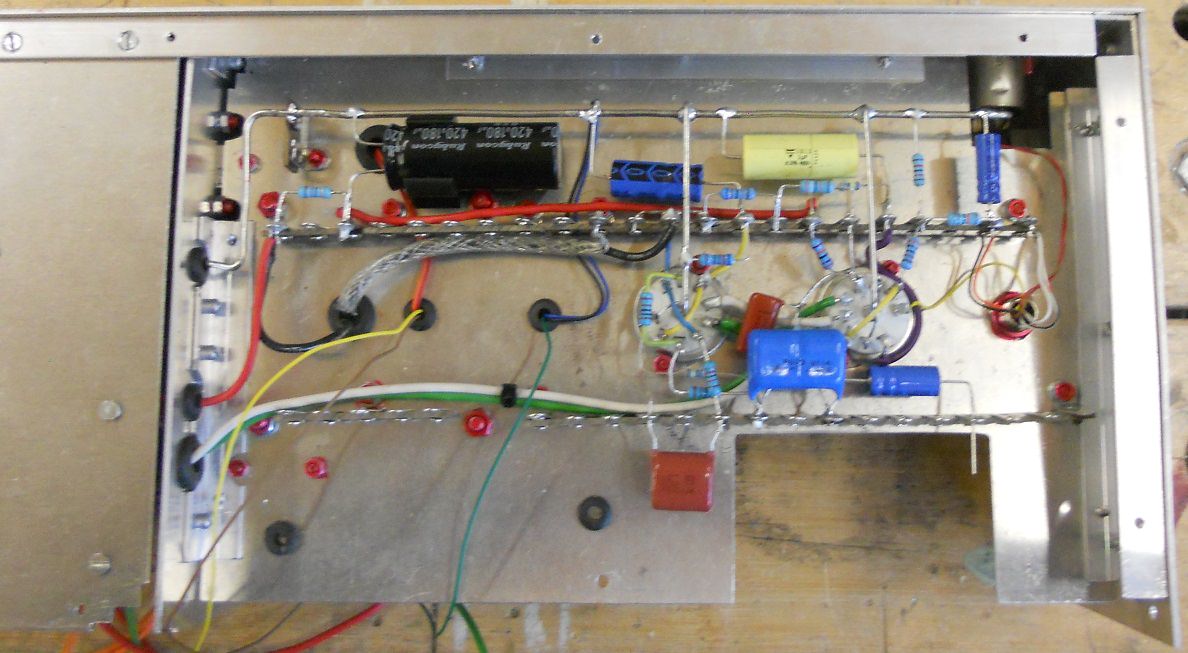
I have used a few new techniques here, I used the braid and transparent cover from an old USB cable, took out the wires and slide the choke feed wire into it, I didn't want such a high output voltage radiating near to the input in case of unwanted feedback.
I have found that PVC wires tend to melt on short runs across the tube base, so I used solid tinned 18SWG with heat shrink sleeves. that way when the wire gets hot from soldering, the sleeve just shrinks but stays intact. Those are the yellow and blue wires. The layout was very difficult because of the complexity of the DC feedback and the size of the Polyprop caps I used, they don't come in axial format unfortunately. The components in the audio chain are of the highest quality and should last indefinitely.
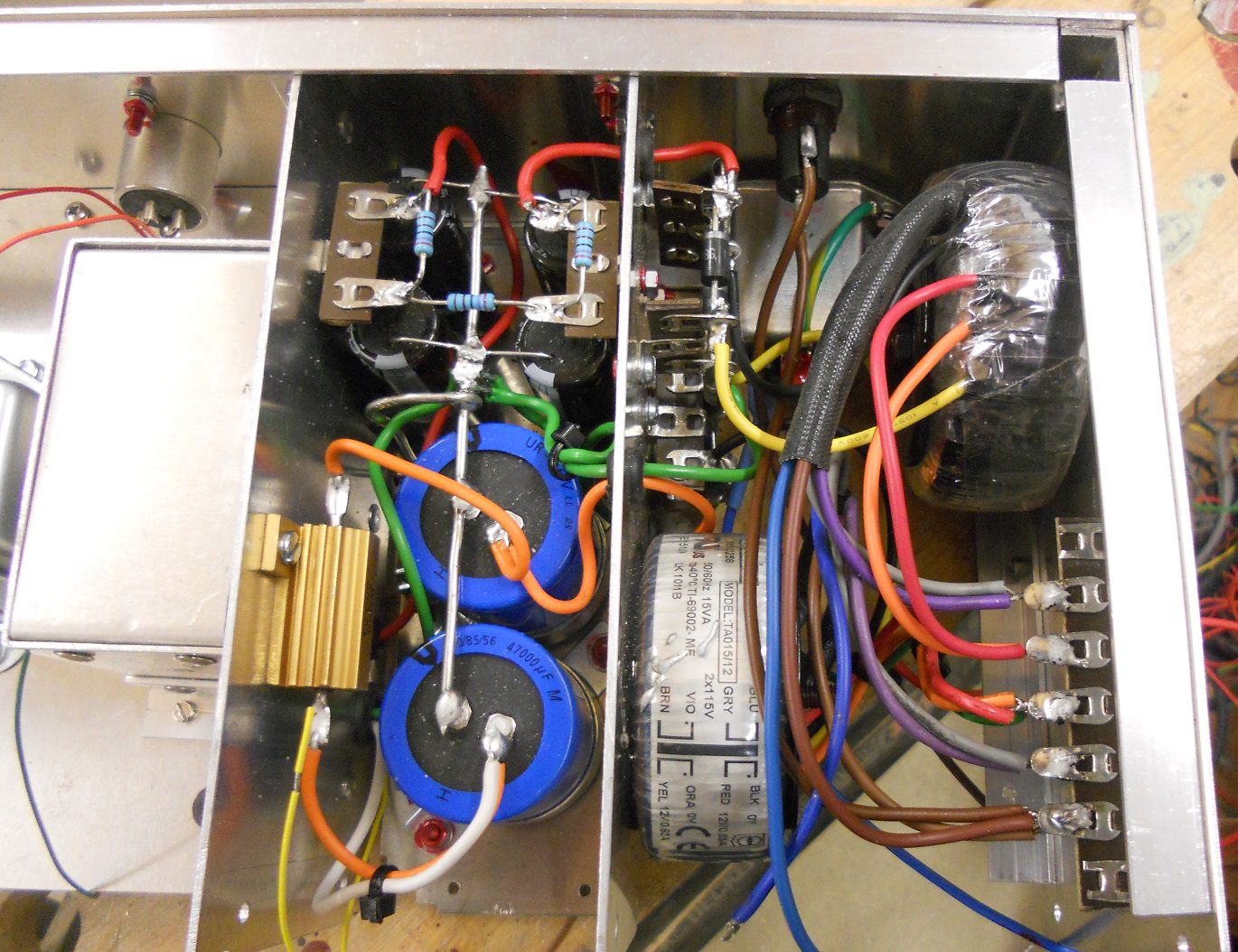
The power supply went much better and I'm pleased with the finished result.
All that remains to do now is the gain switch and the front plate and lettering.
DaveP

I have used a few new techniques here, I used the braid and transparent cover from an old USB cable, took out the wires and slide the choke feed wire into it, I didn't want such a high output voltage radiating near to the input in case of unwanted feedback.
I have found that PVC wires tend to melt on short runs across the tube base, so I used solid tinned 18SWG with heat shrink sleeves. that way when the wire gets hot from soldering, the sleeve just shrinks but stays intact. Those are the yellow and blue wires. The layout was very difficult because of the complexity of the DC feedback and the size of the Polyprop caps I used, they don't come in axial format unfortunately. The components in the audio chain are of the highest quality and should last indefinitely.

The power supply went much better and I'm pleased with the finished result.
All that remains to do now is the gain switch and the front plate and lettering.
DaveP
This is the gain switch finished with its ground wire, plus input and output screened cables. All 1% metal film 0.6W.
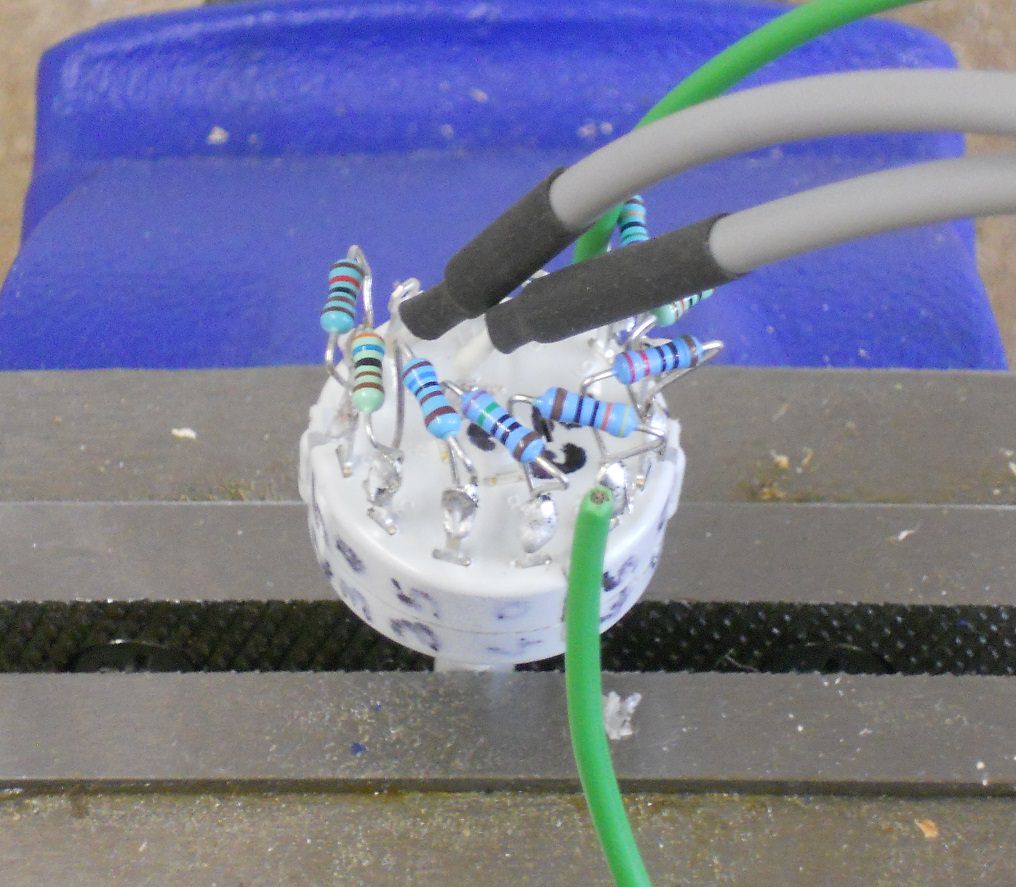
The shield box is finished with its entry grommet.
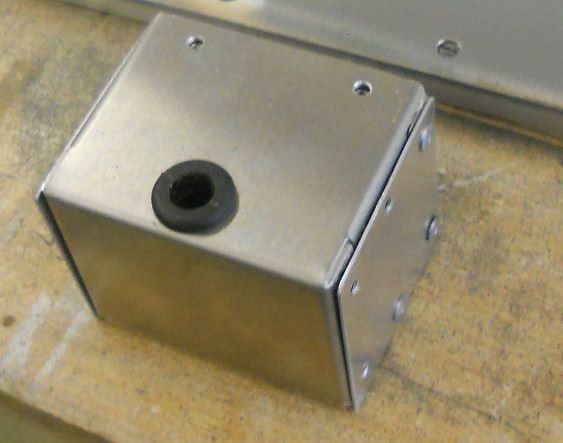
Next job was to buff up some sections of the front plate to a shiny finish.
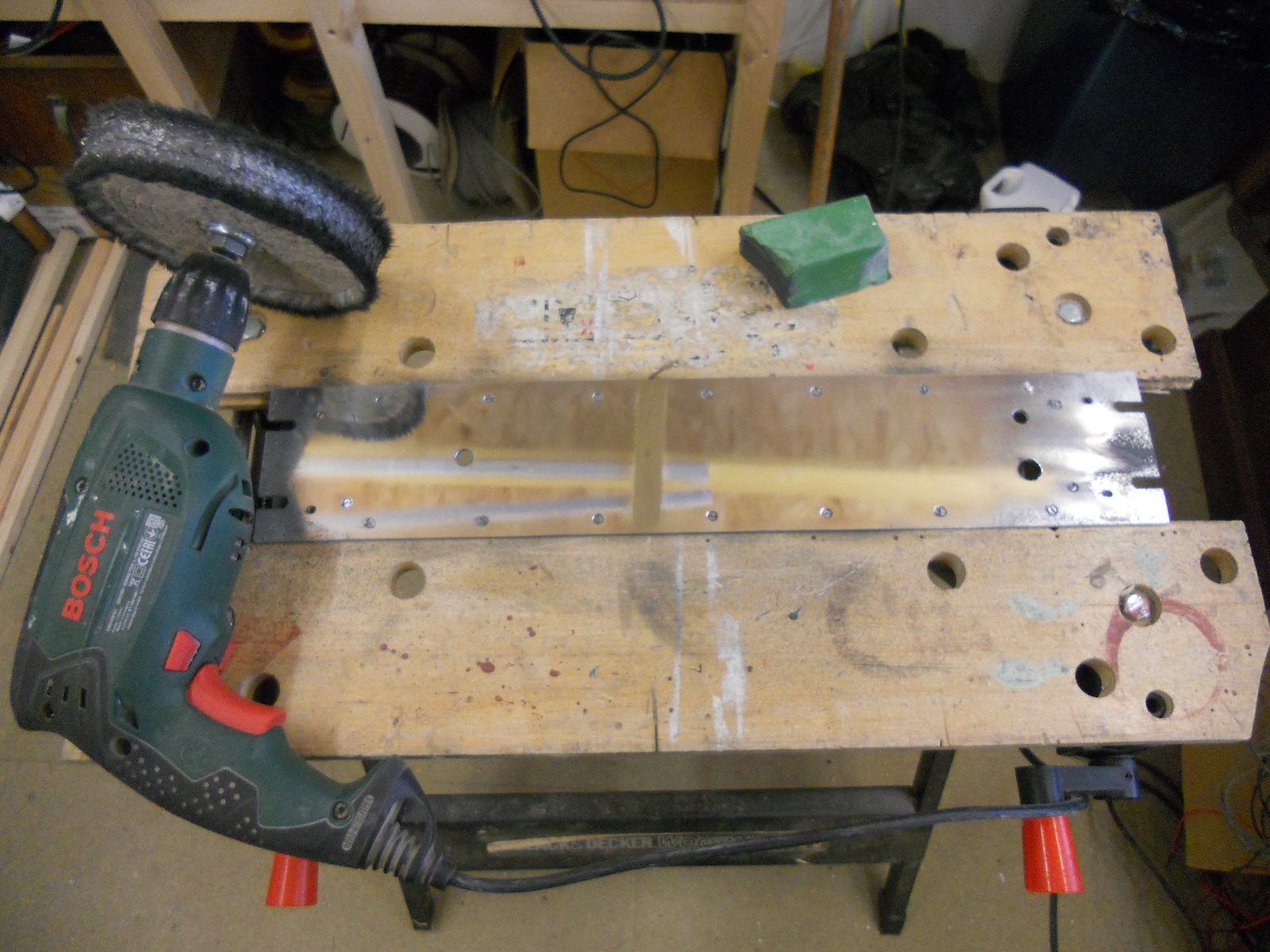
Ignore the reflections of the roof of my workshop, its like a mirror.
The object is to have the lettering shining like chrome on a dark background, we shall have to see if it works out :
DaveP

The shield box is finished with its entry grommet.

Next job was to buff up some sections of the front plate to a shiny finish.

Ignore the reflections of the roof of my workshop, its like a mirror.
The object is to have the lettering shining like chrome on a dark background, we shall have to see if it works out :
DaveP
It's been so cold recently that I've not been into my workshop, so I've started the lettering on the kitchen table, always risky in my house :
I downloaded the German DIN 1451 pre-war font to give it a bit of character.
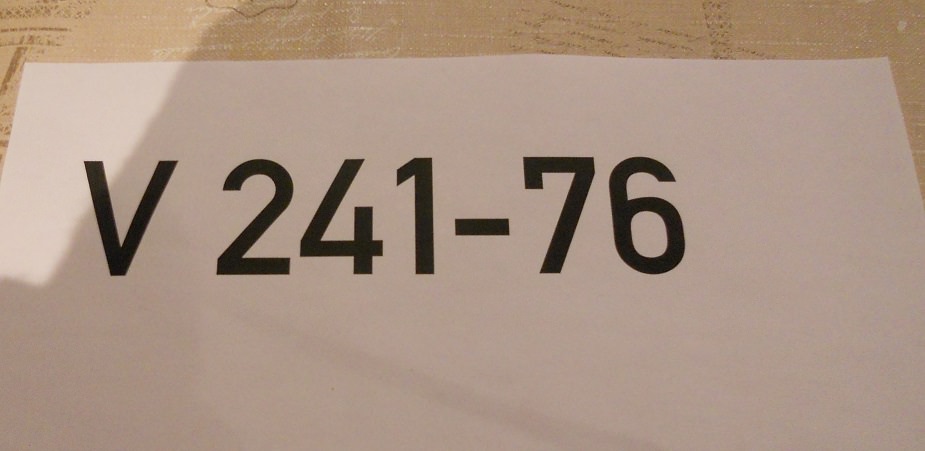
Then I put masking tape over the area where I wanted the lettering and transferred the image with carbon copy paper
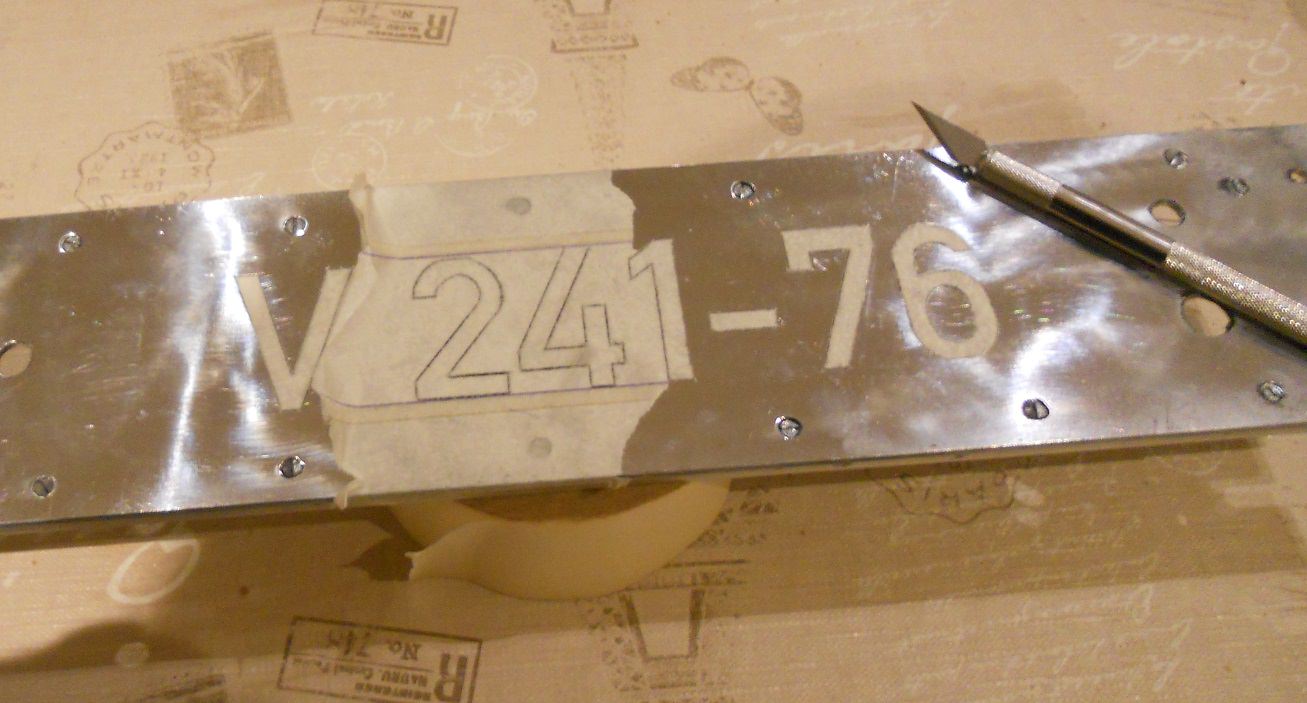
Then it was just very carefully cutting around the lettering with a craft knife.
I shall gently sand and paint the rest so that when I remove the masking tape there will be shiny letters on a dark background.
DaveP
I downloaded the German DIN 1451 pre-war font to give it a bit of character.

Then I put masking tape over the area where I wanted the lettering and transferred the image with carbon copy paper

Then it was just very carefully cutting around the lettering with a craft knife.
I shall gently sand and paint the rest so that when I remove the masking tape there will be shiny letters on a dark background.
DaveP
L´Andratté
Well-known member
Hi Dave!
Do you have experience with this kind of lettering (negative stencil)?
Depending on tape and technique, there are often problems with little fractions of paint getting under the edges->flawed outlines.
Needless to say, that I adore your work!
Do you have experience with this kind of lettering (negative stencil)?
Depending on tape and technique, there are often problems with little fractions of paint getting under the edges->flawed outlines.
Needless to say, that I adore your work!
Yes, that can be a problem, but I used a craft knife this time which puts enormous pressure on the tape edges as it cuts.
I first tried the technique on the Fairchild 660 I made a while back, these were not letters but spaces.
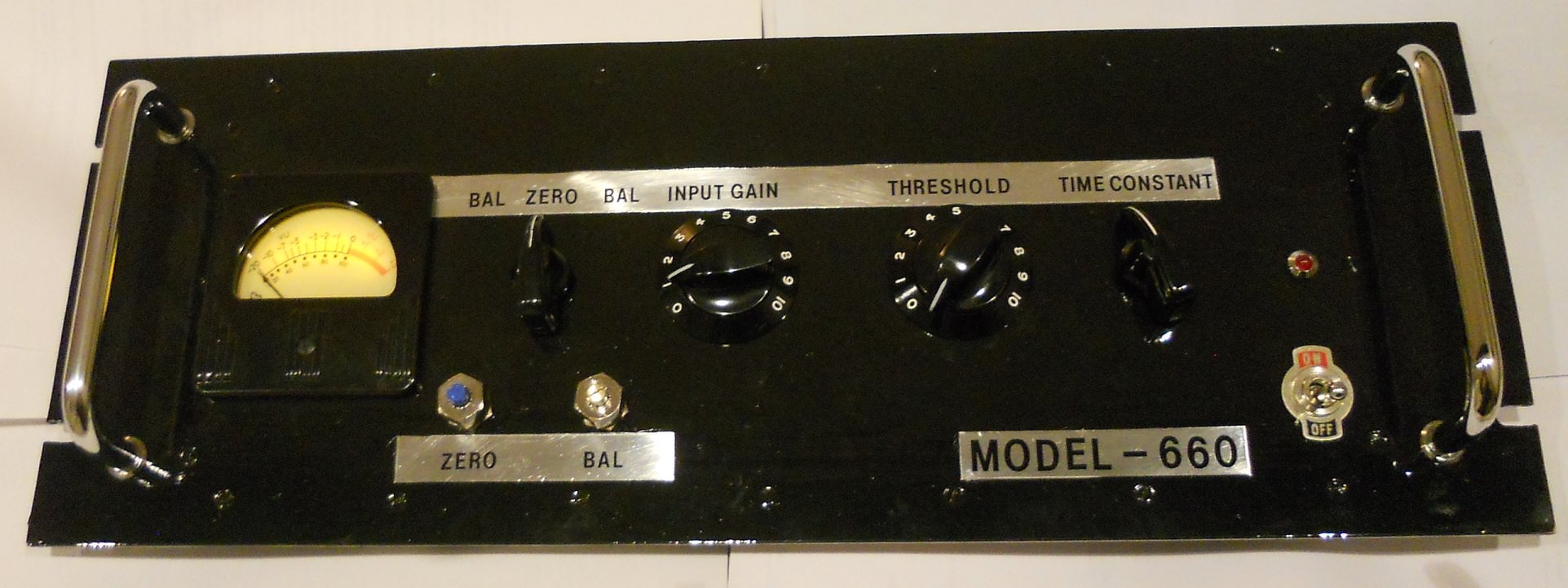
But I didn't use a craft knife that time.
Thanks for your support
DaveP
I first tried the technique on the Fairchild 660 I made a while back, these were not letters but spaces.

But I didn't use a craft knife that time.
Thanks for your support
DaveP
shabtek
Well-known member
Do you use special primer for alu.?
dmp
Well-known member
Did you chose the layout of the transformers and choke knowing they would minimize coupling? (i.e. orientation of the cores and flux fields)?
Also, do you know how much dB of shielding some amount of mu-metal provides?
I am building a v76 right now where I hope to be able to use an internal psu as well
Also, do you know how much dB of shielding some amount of mu-metal provides?
I am building a v76 right now where I hope to be able to use an internal psu as well
@dmp
I did some experiments on shielding before I started the U73 project:-
https://groupdiy.com/index.php?topic=59242.0
I found that power toroids are best mounted vertically rather than horizontally where they can spread their field through the rest of the amp. Also the point where the wires exit needs to be pointing somewhere it doesn't matter.
The orientation of the fields on audio transformers need to be 90 degrees different (one vertical, one horizontal) to avoid pick-up. That is if they are not screened like Edcors for example. I screened the choke in this project because it is a coil radiating a strong audio signal. It is better to preempt these problems than trying to fix them after the event when you have 55dB of gain in the box. I remember an old thread of a guy who made a V76 with uncontrollable oscillation, where the output somehow got coupled to the input.
Distance is best for sensitive stages but screens of magnetic conductive metal help a lot. Jensen said one MuMetal case reduces 30dB and two 60dB, my input TX has the double case, as I'm trying to get close to the V76 noise spec.
DaveP
I did some experiments on shielding before I started the U73 project:-
https://groupdiy.com/index.php?topic=59242.0
I found that power toroids are best mounted vertically rather than horizontally where they can spread their field through the rest of the amp. Also the point where the wires exit needs to be pointing somewhere it doesn't matter.
The orientation of the fields on audio transformers need to be 90 degrees different (one vertical, one horizontal) to avoid pick-up. That is if they are not screened like Edcors for example. I screened the choke in this project because it is a coil radiating a strong audio signal. It is better to preempt these problems than trying to fix them after the event when you have 55dB of gain in the box. I remember an old thread of a guy who made a V76 with uncontrollable oscillation, where the output somehow got coupled to the input.
Distance is best for sensitive stages but screens of magnetic conductive metal help a lot. Jensen said one MuMetal case reduces 30dB and two 60dB, my input TX has the double case, as I'm trying to get close to the V76 noise spec.
DaveP
dmp
Well-known member
DaveP said:@dmp
I did some experiments on shielding before I started the U73 project:-
https://groupdiy.com/index.php?topic=59242.0
I found that power toroids are best mounted vertically rather than horizontally where they can spread their field through the rest of the amp. Also the point where the wires exit needs to be pointing somewhere it doesn't matter.
The orientation of the fields on audio transformers need to be 90 degrees different (one vertical, one horizontal) to avoid pick-up. That is if they are not screened like Edcors for example. I screened the choke in this project because it is a coil radiating a strong audio signal. It is better to preempt these problems than trying to fix them after the event when you have 55dB of gain in the box. I remember an old thread of a guy who made a V76 with uncontrollable oscillation, where the output somehow got coupled to the input.
Distance is best for sensitive stages but screens of magnetic conductive metal help a lot. Jensen said one MuMetal case reduces 30dB and two 60dB, my input TX has the double case, as I'm trying to get close to the V76 noise spec.
DaveP
Interesting - the "transformer screen" tests you did are very helpful. The 1.5mm of steel only dropped the pickup by 3.5 dB! (20*log(2.4/3.6))
The permeability of mu metal is 10-50 times higher though, which I guess is how transformer shields get up to ~60 dB. I have some of the O-17 UTC shields (25dB) but I've never measured the thickness. Probably about 1 mm.
I think the scaling with distance is not exponential it is a power law. It is known as the square-cube law. Since the surface area of the sphere increases with d^2, the intensity of the interference decreases accordingly. If you took the distance in your graph as x^-2 your plot would be linear.
I don't understand why the shielding is improved from sandwiched layers rather than a solid shield. My understanding was the shielding absorbs the magnetic field. There is some good stuff here:
http://www.magnetic-shield.com/faqs-all-about-shielding.html
I got the E90 version of the input transformer (90 dB shield) and have the same output transformer you are using. But I need to mount the PT horizontal so I will have to make some good shielding for it I expect. And shielding for the chokes as you did. With the input transformer vertical, is it oriented 90 deg from the output / choke? I don't know what is in the can.
The original v76 has all the chokes and transformers packed together tightly, so it can be done. I expect the V-241 does to, but I haven't seen any internal pics.
The shielding doesn't absorb the magnetic field, it conducts it around the object in question.I don't understand why the shielding is improved from sandwiched layers rather than a solid shield.
The multiple layers cause the field to weaken because of the difficulty it faces in moving from one medium to another. The gap in single ended transformers reduces the inductance, I surmise the effect is similar.
I think the orientation of the choke and IPT is the same, but I'm hoping they are too well shielded from each other for there to be any coupling.
Nice to talk to you on this subject than just on the Brewery!
DaveP
Similar threads
- Replies
- 575
- Views
- 102K
- Replies
- 12
- Views
- 5K









![Soldering Iron Kit, 120W LED Digital Advanced Solder Iron Soldering Gun kit, 110V Welding Tools, Smart Temperature Control [356℉-932℉], Extra 5pcs Tips, Auto Sleep, Temp Calibration, Orange](https://m.media-amazon.com/images/I/51sFKu9SdeL._SL500_.jpg)























